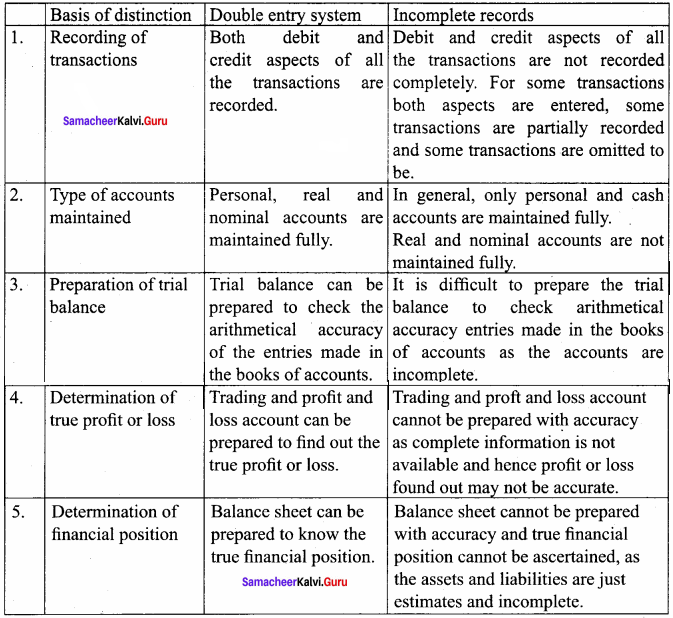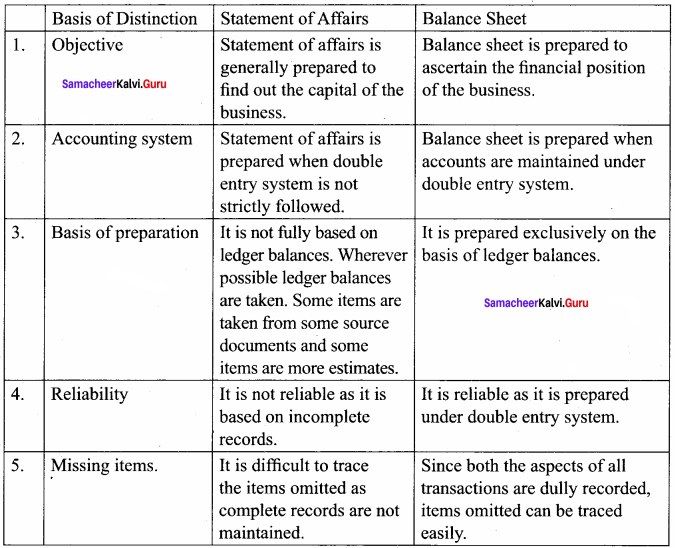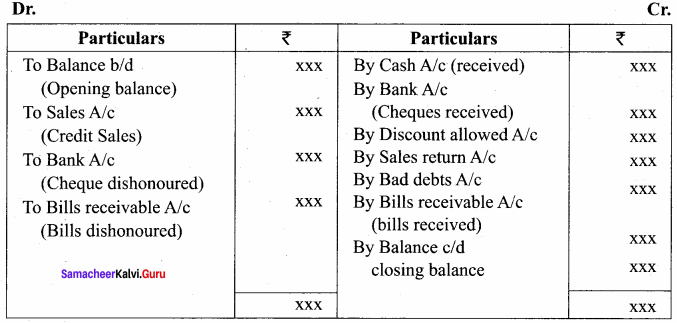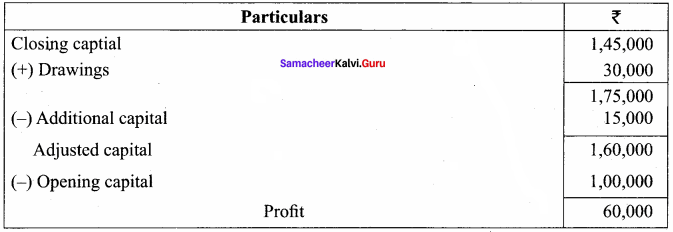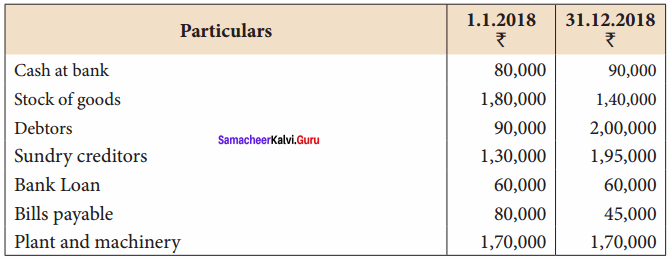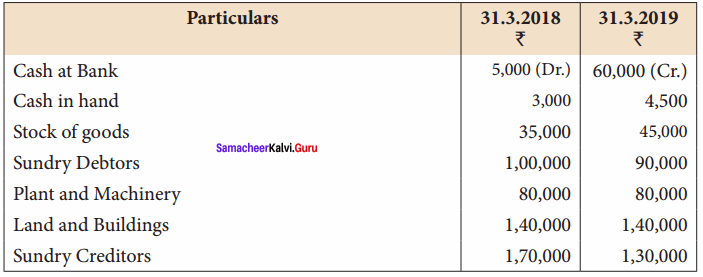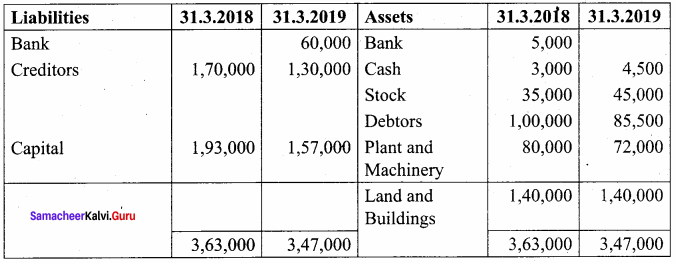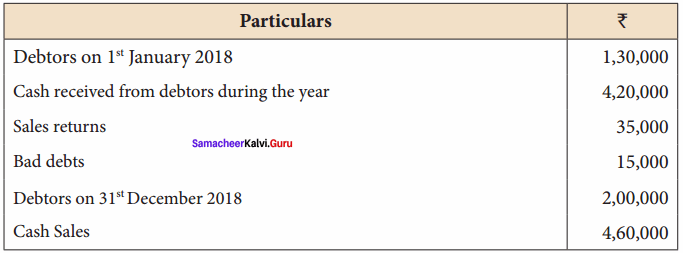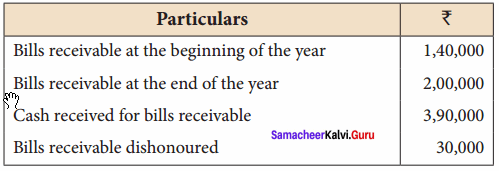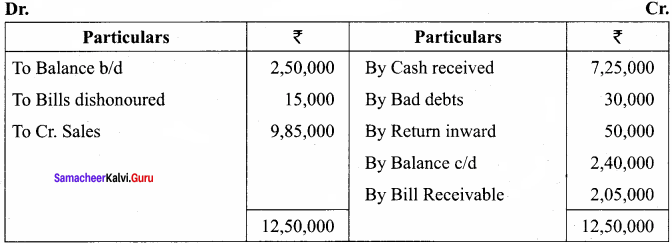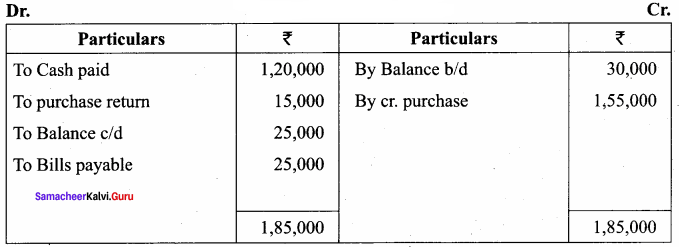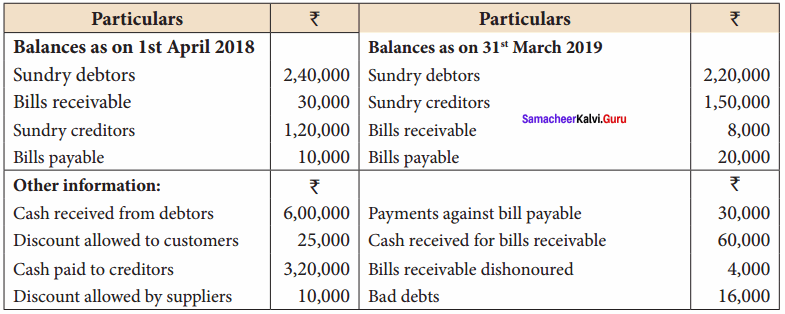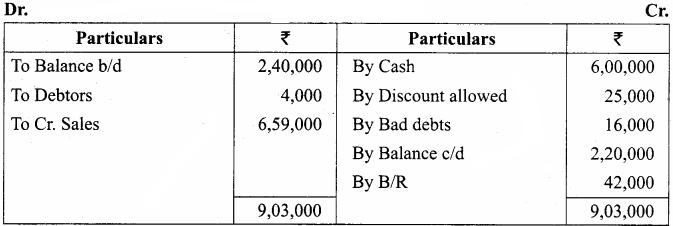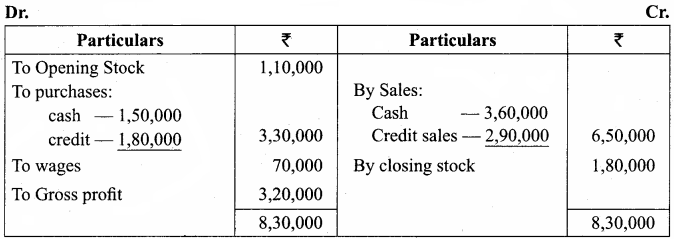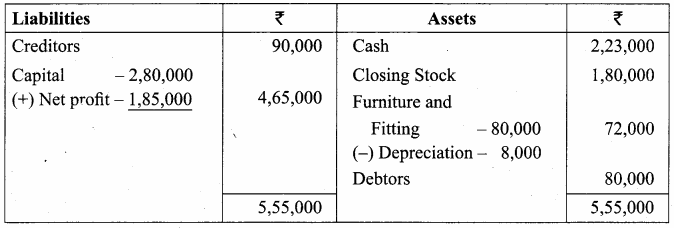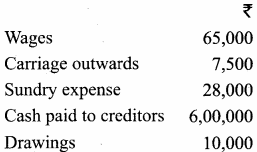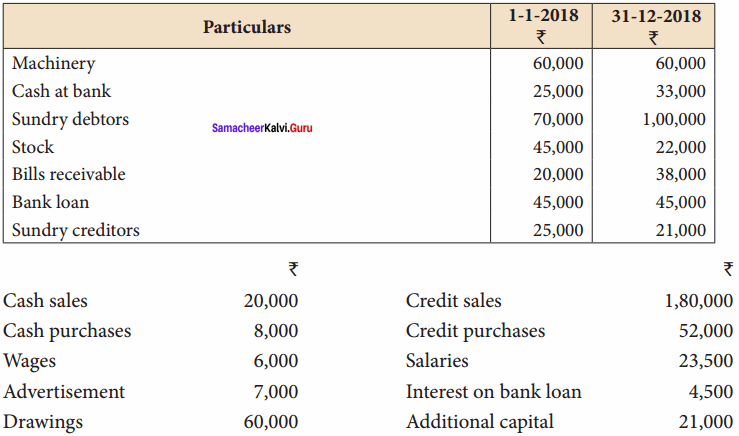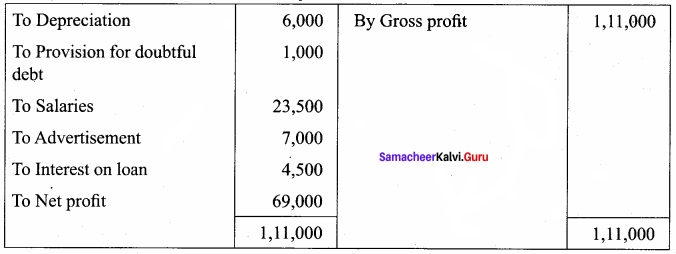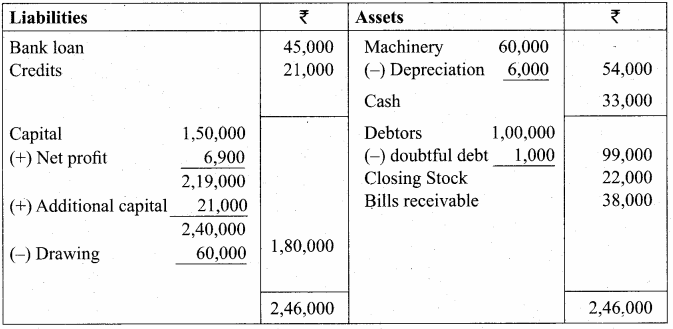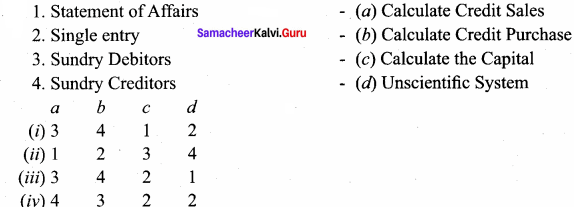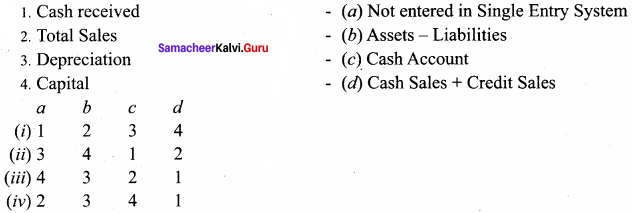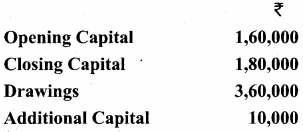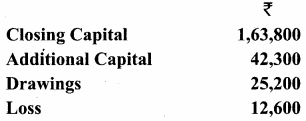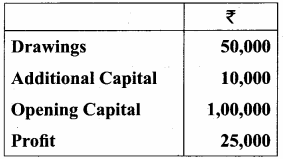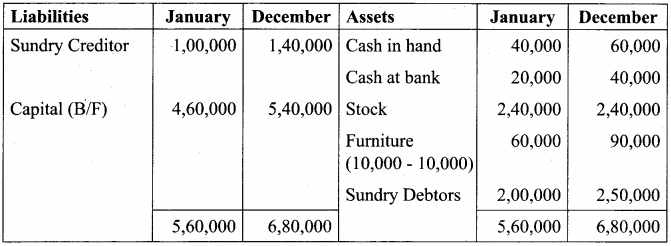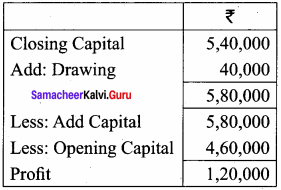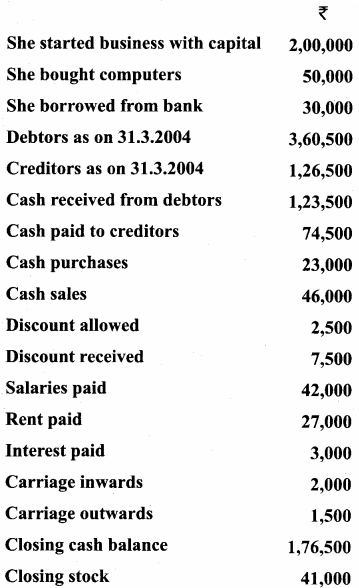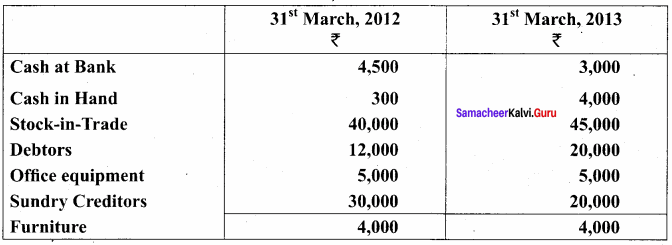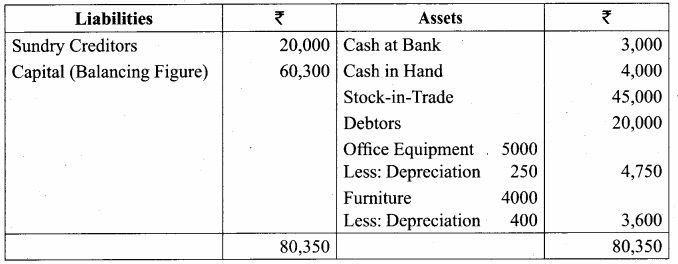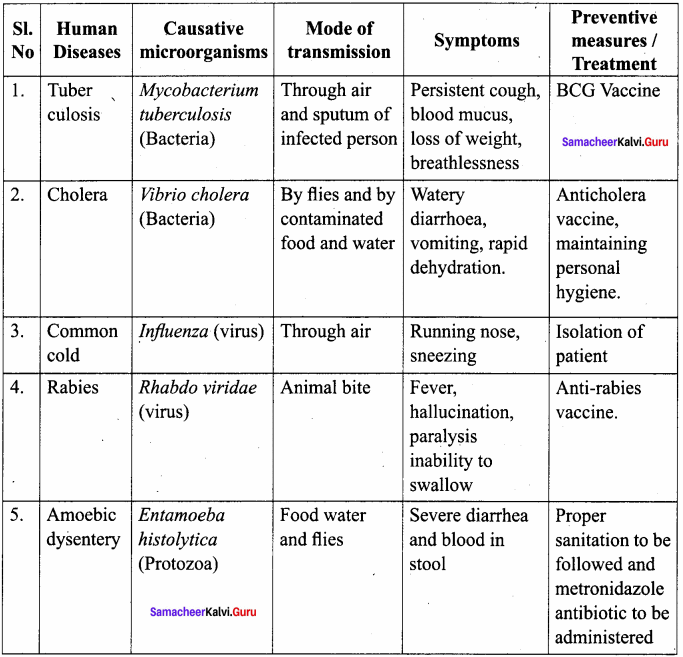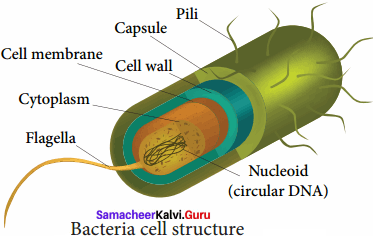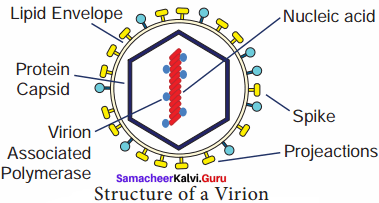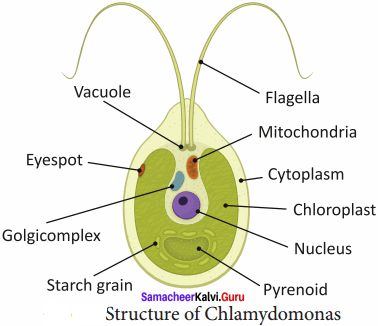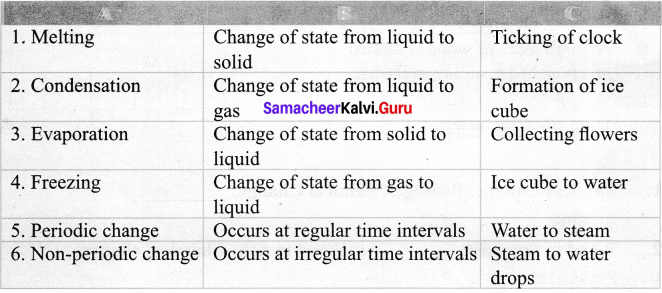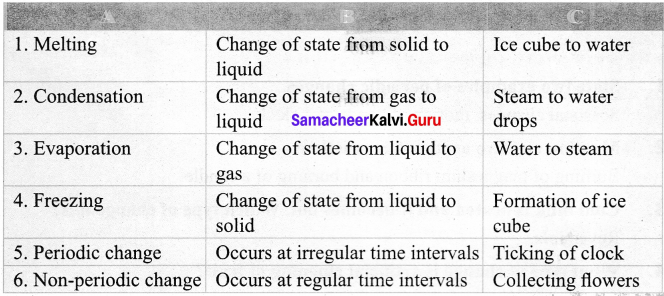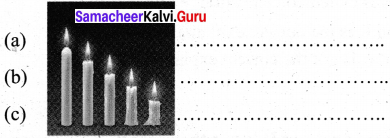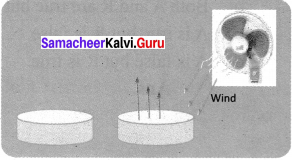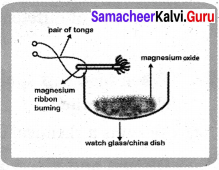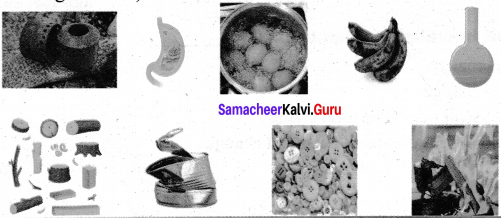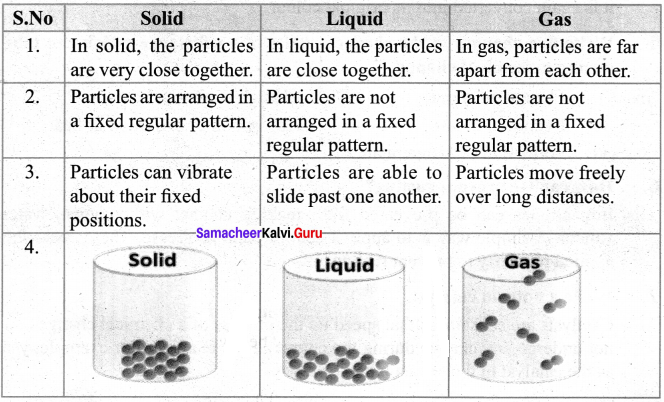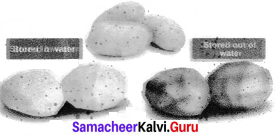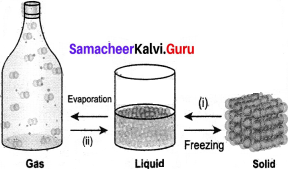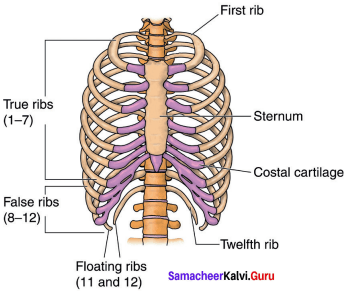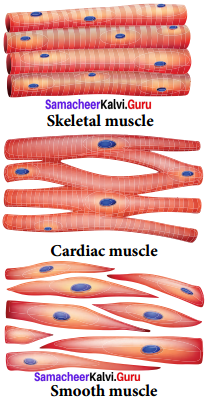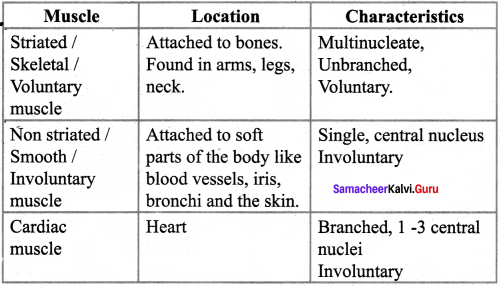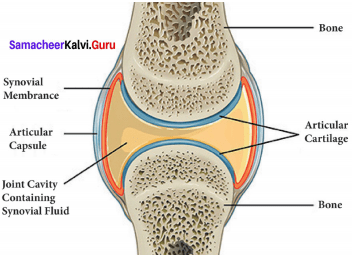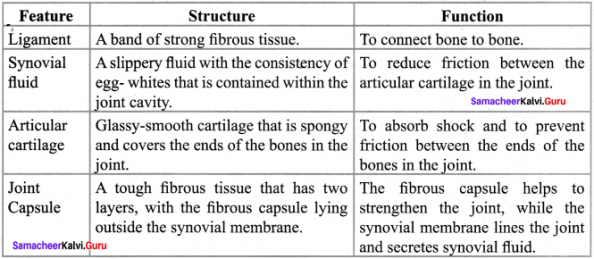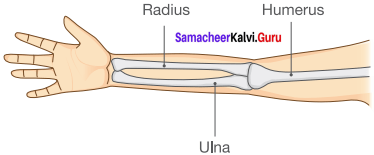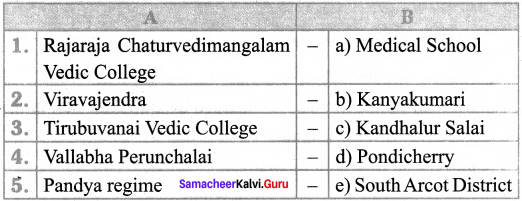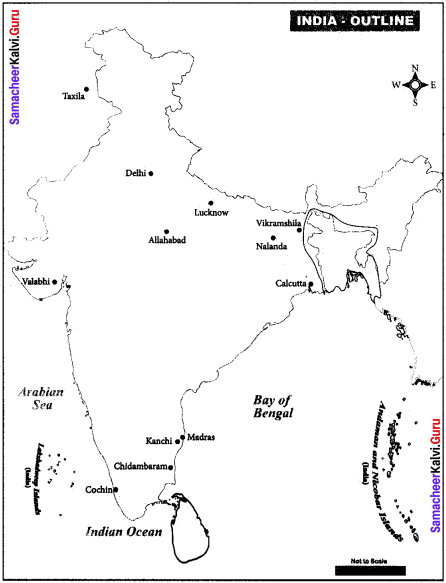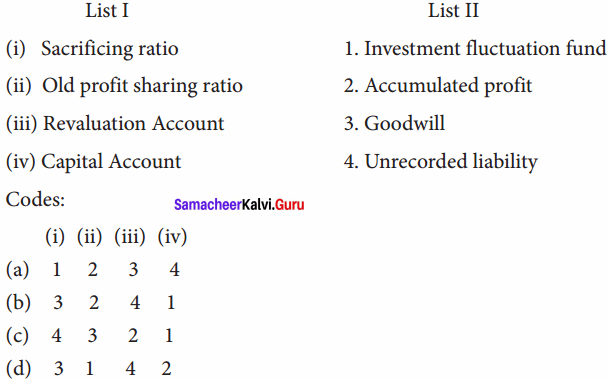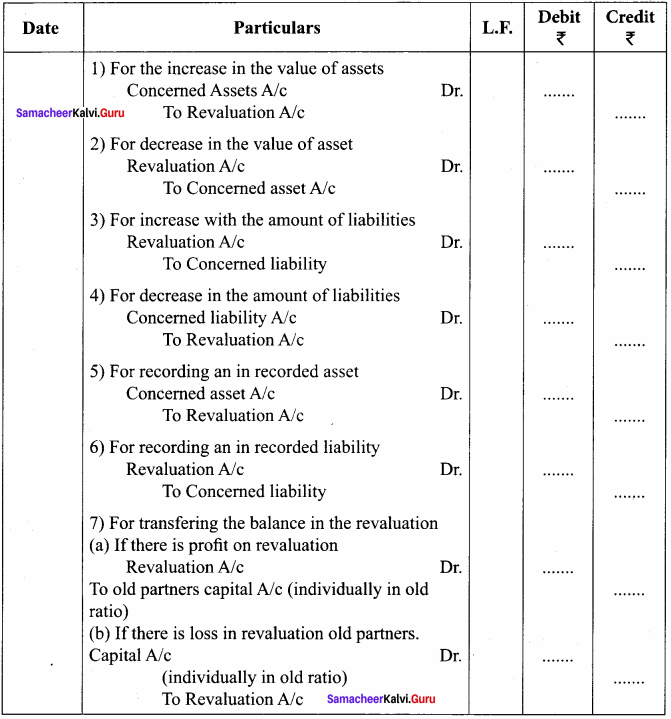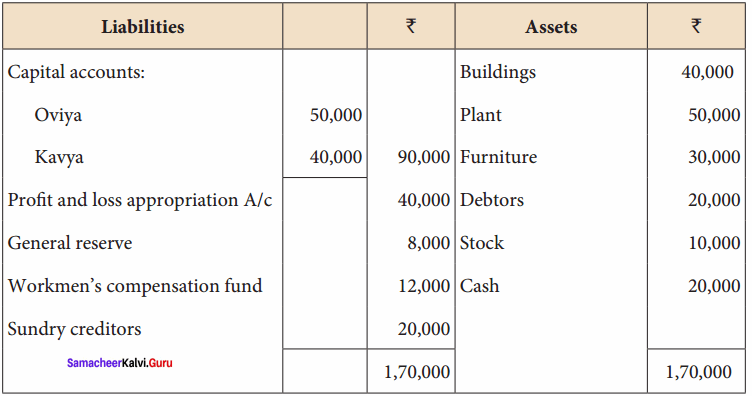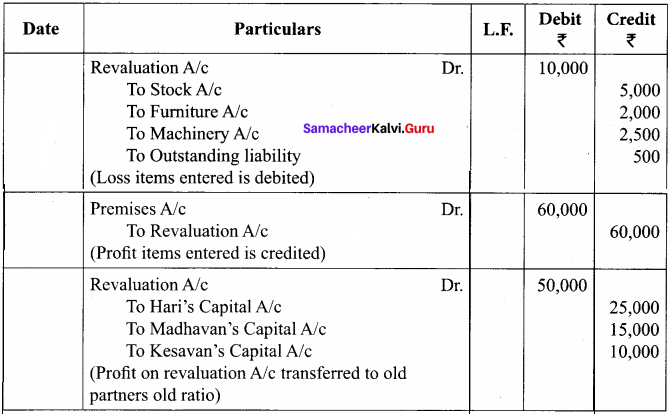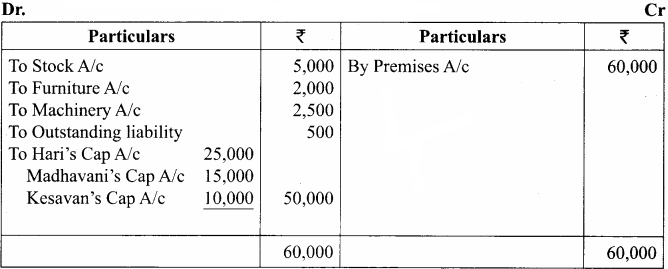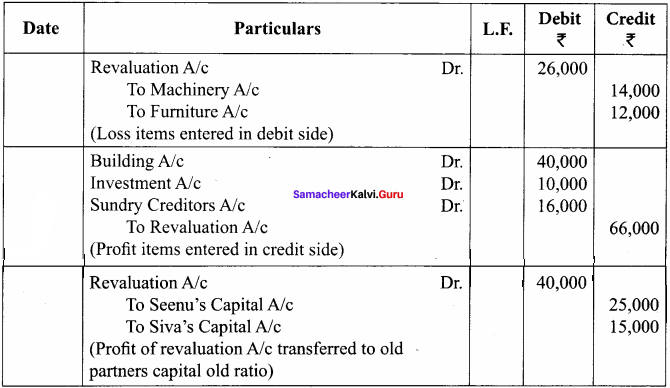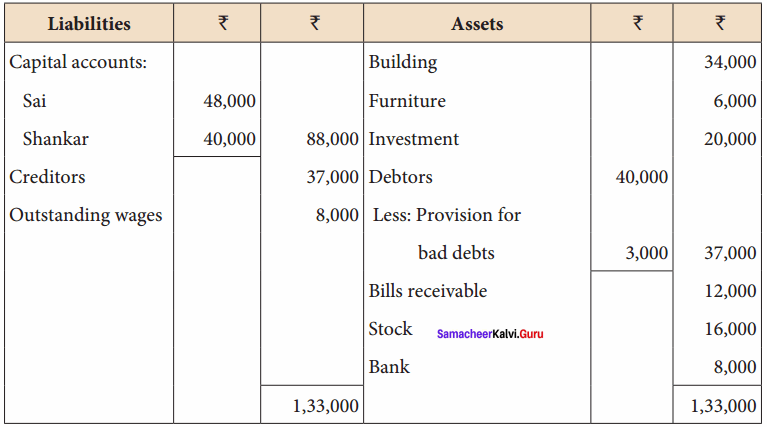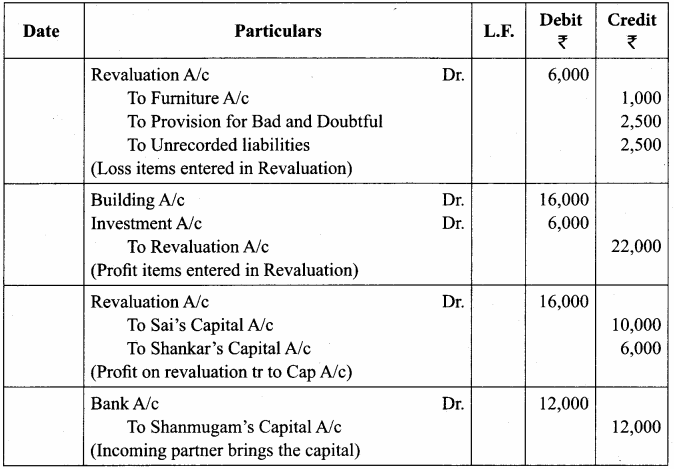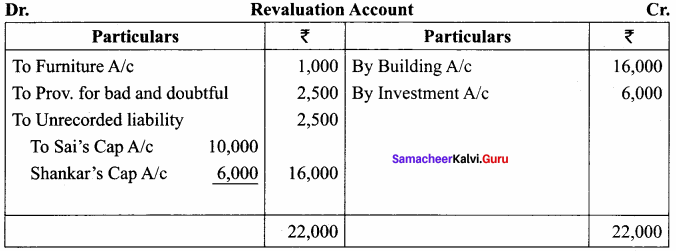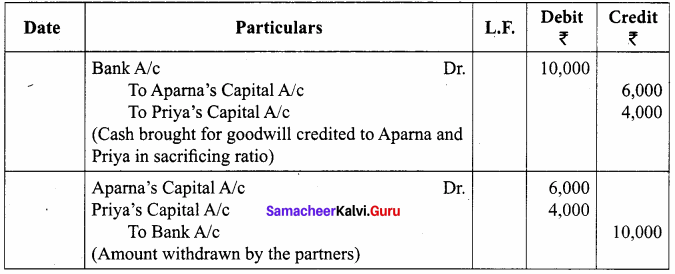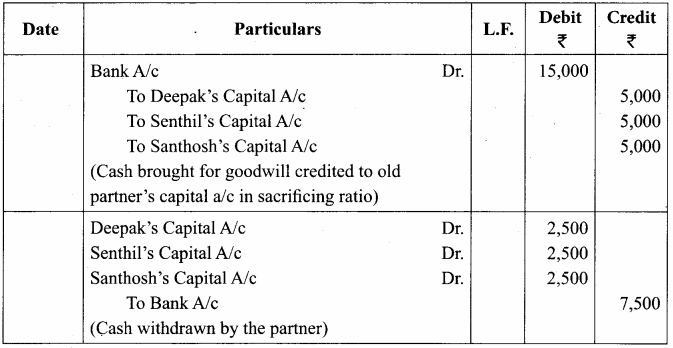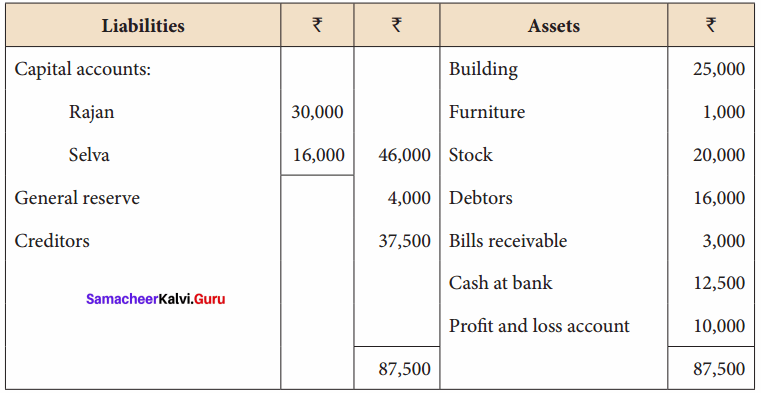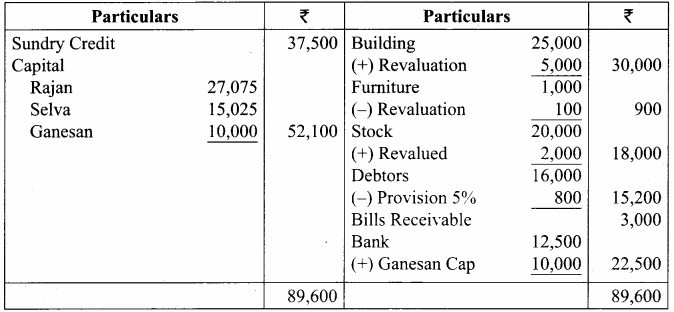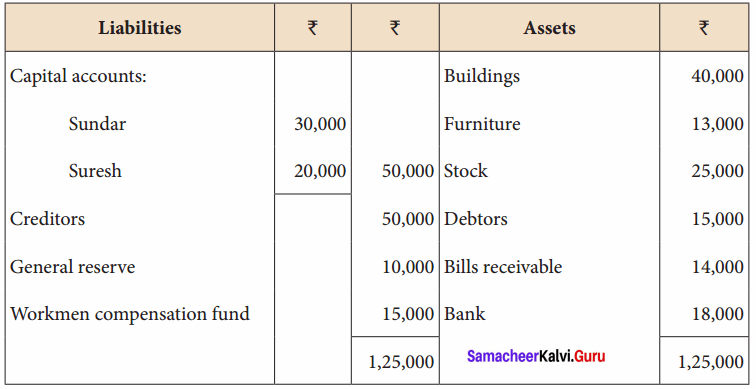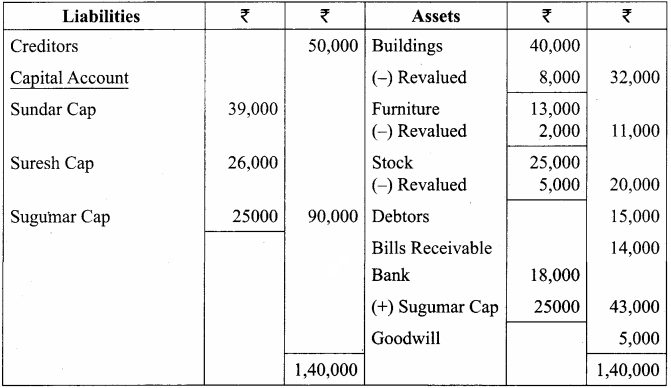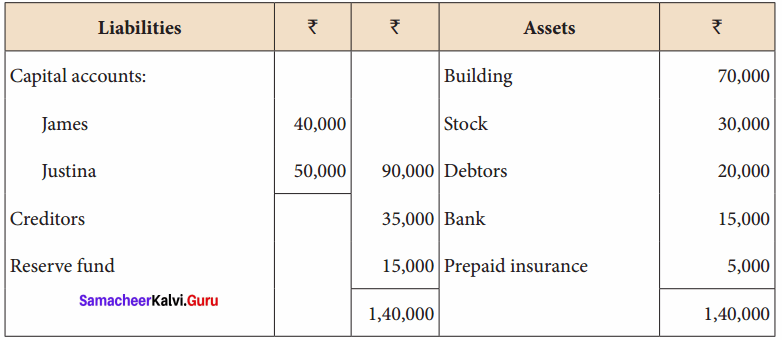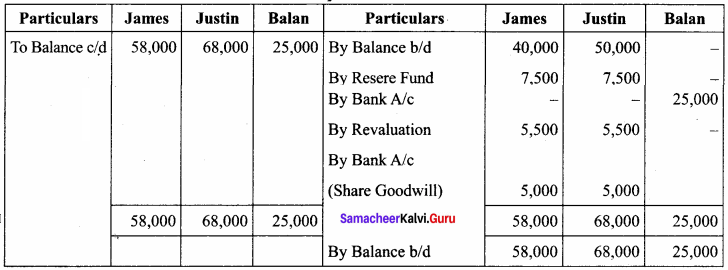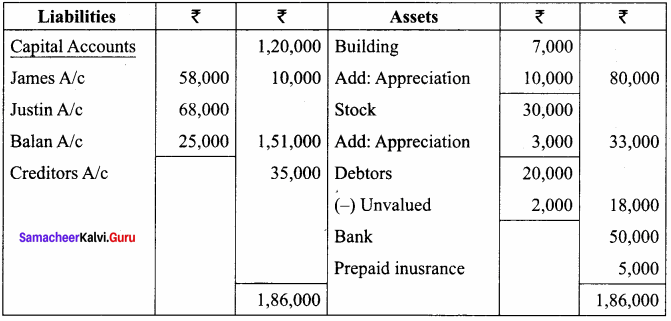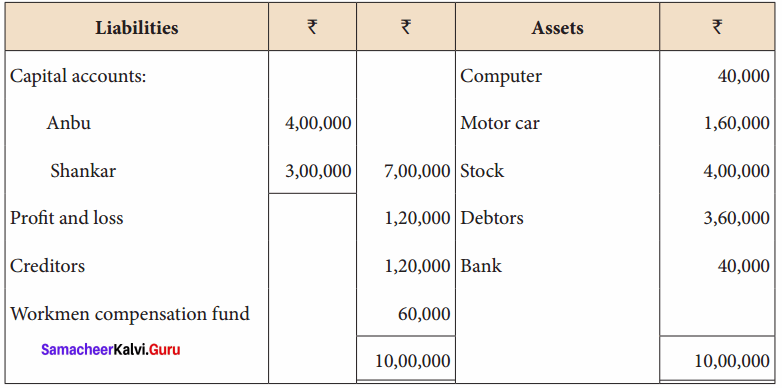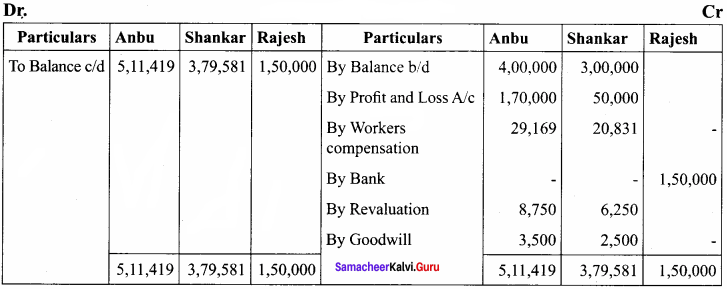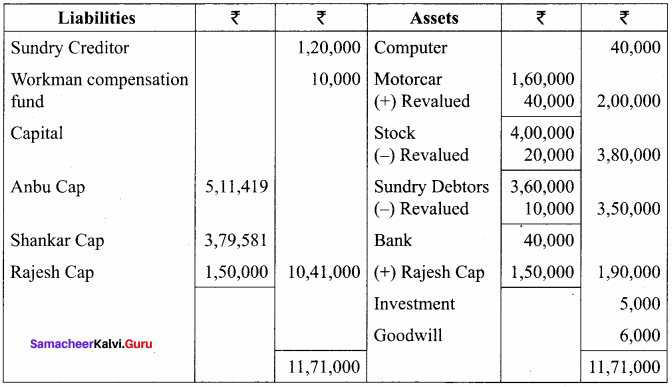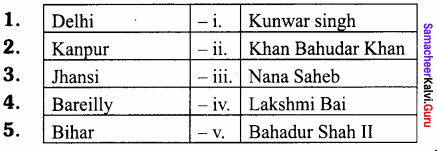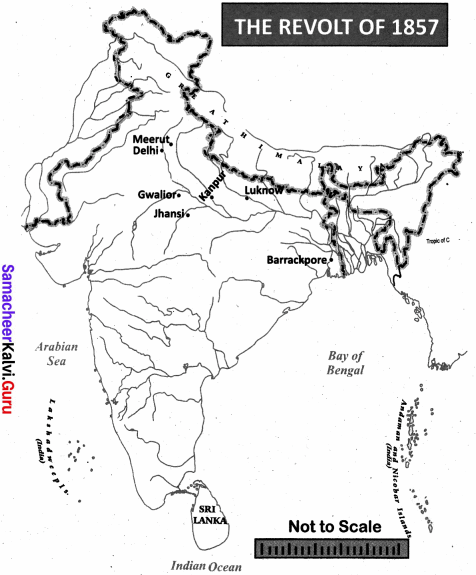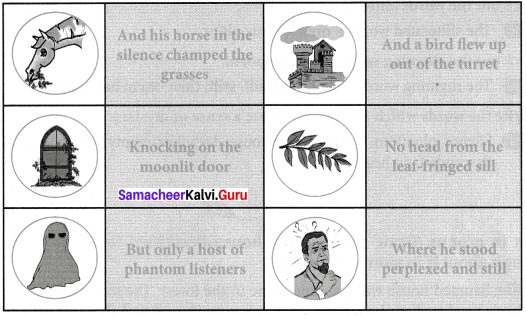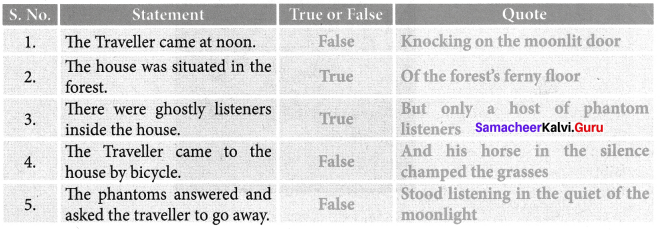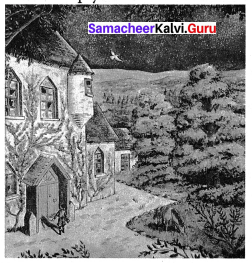Students can Download English Lesson 1 Owlie Questions and Answers, Summary, Activity, Notes, Samacheer Kalvi 6th English Book Solutions Guide Pdf helps you to revise the complete Tamilnadu State Board New Syllabus and score more marks in your examinations
Tamilnadu Samacheer Kalvi 6th English Solutions Term 1 Supplementary Chapter 1 Owlie
Mind Map
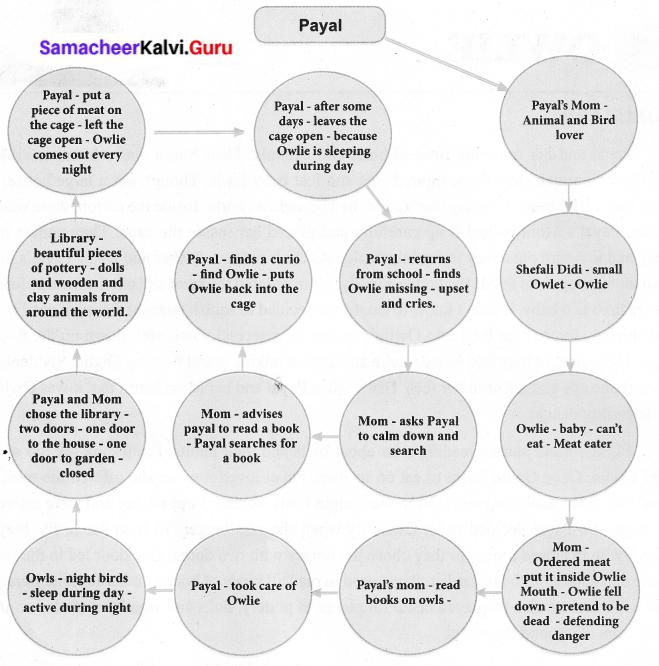
A. identify the character / speaker,
Owlie Supplementary Question And Answer Question 1.
Owlie’s gone!
Answer:
Payal to Mom.
Owlie’s Gone Question 2.
She opened one eye and then the other.
Answer:
Owlie.
Question 3.
Don’t panic.
Answer:
Mom to Payal.
Identify The Character / Speaker : Additional
- “Well, now Owlie has gone”. – Mom to Payal
- ‘Where would she have gone, Payal?’ – Mom to Payal
- ‘She was right there, sleeping in her cage, a little while ago’. – Mom to Payal
- ‘Mom, what shall we call her?’ – Mom to Payal
- ‘How about Owlie?’ – Mom to Payal
- ‘Oh, what have I done?’ – Mom to Payal
- ‘She must be somewhere around’. – Mom to Payal
- ‘Why don’t you find yourself a good book to read? – Mom to Payal
- ‘Mom! she’s back’. – Payal to Mom
- Tears rolled down Payal’s cheeks. – The author
- ‘Don’t you ever give me a fright like that again’. – Payal to the ow
B. Choose the correct answer from the options given.
- The owlet was _______ (brown and grey / white and grey)
- In Payal’s family, they were all _______ (non-vegetarian / vegetarian).
- The cage was shifted to the _______ (library / living room).
Answers:
- brown and grey
- vegetarian
- library
Mcq: Additional
- As Owlie was a baby, it didn’t know to _______ ( eat / dance)
- Payal’s Mom was hesitant to _______ inside the house, (bring Owlie / bring meat)
- Payal’s Mom started reading a lot about _______ (owls and their habits / feeding animals)
- Owls were _______ so they slept all day and were active during the night. (night birds / day birds)
- In the library , one door led to the rest of the house and another into _______ (kitchen / garden)
- The book shelves also displayed _______, dolls and wooden and clay animals. (beautiful pieces of pottery / glass jars)
- Payal left the cage door open as Owlie was _______ during the day. (eating / sleeping)
- Payal panicked because _______ (the cage was empty / Owlie had died)
- Payal’s Mom advised her _______ to cheer up. (to go for a ride / to read some book)
- Payal noticed a _______ on the book shelf, (curio / tom book)
Answers:
- eat
- bring meat
- owls and their habits
- night birds
- garden
- beautiful pieces of pottery
- sleeping
- the cage was empty
- to read some book
- curio
C. Read the passage and answer the questions.
Payal and her mother started talking bravely about where to bury Owlie. Just then, Owlie opened one eye and then the other. She got onto her feet and quietly climbed the perch! Payal learnt later that falling on her back and pretending to be dead was Owlie’s way of defending herself against danger.
Owlie Questions And Answers Question 1.
Why did Payal and her mother want to bury Owlie?
Answer:
They thought that Owlie had died.
Owlie Question 2.
What did Owlie do then?
Answer:
Owlie opened one eye and then the other.
6th Standard English Supplementary Owlie Question Answers Question 3.
What did Payal learn from Owlie’s pretence?
Answer:
Owlie leamt the way of defending herself.
Read The Passage and Answer the Questions ; Additional
1. Owls are hunters. They eat rats and snakes and frogs. ’And in Payal’s house, they were all vegetarian, even the dogs! Payal’s mother was totally anti-meat. But now that Owlie had come to stay, she had to get over her dislike for meat. That was another reason why that day was memorable. It was the first day that meat was brought to the house! Payal got the number from her friend and called the meat shop to ask them to deliver half a kilogram of minced meat to the house. They put the meat before Owlie.
Owlie Supplementary Summary Question a.
What did Payal’s Mom dislike to do ?
Answer:
Payal’s Mom disliked to bring meat into the house.
Owlie Supplementary Question b.
Why was the day memorable ?
Answer:
The day was memorable as it was the first day that meat was brought to the house.
Owlie Lesson 6th Standard Question c.
How did Payal get the meat for Owlie ?
Ans.
Payal got the number from her friend and called the meat shop to ask them to deliver half a kilogram of minced meat to the house.
2. Reading up more about owls and their habits, Payal discovered that Owlie was a Spotted Owlet. She had the typical grey-brown coat, heavily spotted with white, the pale face, yellow eyes and the white neckband, which looked like a ribbon, Payal decided. Soon, Payal took over the job of looking after Owlie. She saw that the cage was cleaned every day.She filled the water bowl. Once Owlie began to eat by herself, Payal too could feed her.
Samacheer Kalvi Guru 6th English Question a.
What did Payal’s mom discover by reading books on Owls?
Answer:
Payal’s Mom discovered that the Owlie was a Spotted Owlet.
6th Standard English Supplementary Owlie Question b.
Describe the appearance of Owlie ?
Answer:
Owlie had a typical grey-brown coat, heavily spotted with white, the pale face, yellow eyes and a white neckband.
Samacheerkalvi.Guru 6th English Question c.
What was Payal’s job in taking care of Owlie ?
Answer:
Payal cleaned the cage and filled the water bowl everyday.
3. Once Owlie was moved to the library, strict rules were laid down for everyone in the house. The two doors were never to be left open – not at night, not in the day. Every night, Payal would leave the cage door open and put a plate of mincemeat on top of the cage. This was so that when Owlie flew out of her cage, she could also learn to find her food.
6th Standard Supplementary Question a.
What were the rules ?
Answer:
The two doors were never to be left open – not at night, not in the day. Every ‘ night, Payal would leave the cage door open and put a place of mincemeat on top of the cage.
The Owlet Was Answer Question b.
Why was the meat placed on the top of cage ?
Answer:
The meat was placed on the top of the cage so that Owlie would fly out of the cage and leam to find her food.
Supplementary Owlie Question c.
Where was Owlie moved ?
Answer:
Owlie was moved into the library.
4. Every day when Payal came back from school, the first thing she did was to peep into the library. Usually, she would find Owlie fast asleep on her perch. But today, it was different. The cage was empty and there was no sign of Owlie! And the door to the garden was open.‘Mom!’ Payal howled. ‘Who left the garden door open? How will we find Owlie now? ‘Don’t panic,’ said Mom. ‘She must be somewhere around.’ They shut the garden door and looked in every comer of the room. Behind doors, on top of the tall bookshelves, in every nook and cranny. No Owlie.
Question a.
What did Payal do everyday when she returned from school ?
Answer:
Everyday Payal would peep into the library and find Owlie fast asleep on her perch inside the cage.
Question b.
What was different today when Payal returned from School ?
Answer:
Today, the cage was empty and there was no sign of Owlie when Payal returned from School.
Question c.
What did Payal and Mom do when they found that Owlie was missing ?
Answer:
Payal and Mom shut the garden door and looked in every comer of the room. They searched behind the doors, on top of the tall bookshelves and in every nook and cranny.
D. Rearrange the following jumbled sentences in the correct order.
- Payal’s house was a home for abandoned animals.
- It was a small ball of brown and grey.
- She found an owlet in one comer.
- Payal’s mother picked her up gently.
- Payal’s mother opened the carton.
- One day they got a carton.
Answer:
- Payal’s house was a home for abandoned animals.
- One day they got a carton.
- Payal’s mother opened the carton.
- She found an owlet in one comer.
- It was a small ball of brown and grey.
- Payal’s mother picked her up gently.
Rearrange The Following Jumbled Sentences ; Additional
A.
1. When the owl got used to her, and seemed relaxed enough, Payal’s mother placed her inside a cage.
2. When Payal’s mother opened the carton, there was the smallest of owlets sitting in , one comer, a small ball of brown and grey.
3. There were always empty cages in Payal’s house – just in case a bird dropped in!
4. She had never handled owls before, so she was very careful not to get pecked.
5. Payal’s mother picked her up gently and placed her in her lap, talking to her just as she would to the dogs.
Answer:
2, 5, 4, 1, 3
2. When Payal’s mother opened the carton, there was the smallest of owlets sitting in one comer, a small ball of brown and grey.
5. Payal’s mother picked her up gently and placed her in her lap, talking to her just as she would to the dogs.
4. She had never handled owls before, so she was very careful not to get pecked.
1. When the owl got used to her, and seemed relaxed enough, Payal’s mother placed her inside a cage.
3. There were always empty cages in Payal’s house – just in case a bird dropped in!
B.
1. After all, people seldom went into that room all day, and Owlie was always asleep, so there seemed little point.
2. But Payal knew Owlie was flying because she found bits of meat all over the room.
3. After some time, Payal stopped shutting the cage door even during the day.
4. She would always find Owlie on her perch inside the cage, though the cage door was still open.
5. Initially, Payal would shut the cage door every morning when she popped in to say hello to Owlie before going to school.
Answer:
5, 4, 2, 3,-1
5. Initially, Payal would shut the cage door every morning when she popped in to say hello to Owlie before going to school.
4. She would always find Owlie on her perch inside the cage, though the cage door was still open.
2. But Payal knew Owlie was flying because she found bits of meat all over the room.
3. After some time, Payal stopped shutting the cage door even during the day.
1. After all, people seldom went into that room all day, and Owlie was always asleep, so there seemed little point.
C.
1. Where did this one come from, she wondered.
2. She noticed a curio on a shelf that she had never noticed before. Hello?
3. Where did her mother get the owl from?
4. It was Owlie pretending to be a curio! ‘Mom!’ bawled Payal.
5. She was about to pick it up when the curio opened one eye…
Answer:
2, 1, 3, 5, 4
2. She noticed a curio on a shelf that she had never noticed before. Hello?
1. Where did this one come from, she wondered.
3. Where did her mother get the owl from?
5. She was about to pick it up when the curio opened one eye.
4. It was Owlie pretending to be a curio! ‘Mom! ’ bawled Payal.
E. Discuss in pairs. Then write the answers.
Question 1.
What kind of a girl was Payal? What did she like? How did she behave with animals and people?
Answer:
Payal was a kind hearted girl. She liked pets. She behaved with love and care.
Question 2.
Do you think Owlie was happy to be with Payal? Give reasons for your answer.
Answer:
Yes, Owlie was very happy to be with Payal. It did not leave the house. It adapted the home well.
Project
F. Listen to the teacher read the passage, watch this website: https://sstcn.org/ Then write a Paragraph on students Turtle Walk Channai 2017.
It is a night long trek/walk along the beaches of Chennai between December to April. It is a breeding season of the Olive Ridley turtles. One has to volunteer with the students’conservation society and walk along the beaches, fishing hamlets looking out for turtle nests. The eggs are collected from these nests and kept at an artificial environment until the eggs hatch. After 21 days, the hatchlings are let back into the sea water safely. This is done in order to protect these eggs which otherwise have a very high threat of getting killed by many external factors. The volunteering is open to general public who is genuinely concerned about conserving this endangered reptile species.
Connecting To Self
G. Write a caption for these pictures. One is done for you
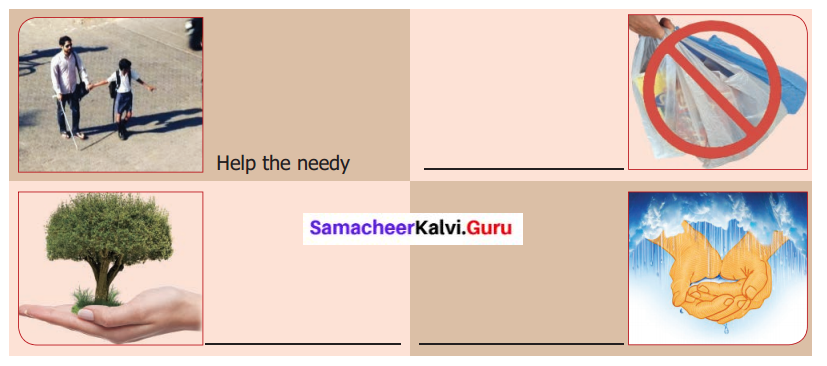
Answer:
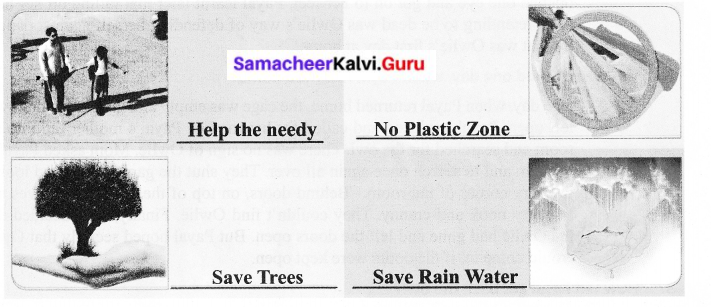
Steps To Success
H. Find the group name and write them in the blanks. One is done for You.
eg: elephant, tiger, lion, monkey – Land animals
- eel, seal, walrus, seahorse
- pearl, coral,conch, oil
- submarine, ship, yacht, ferry
- kite surfing, scuba diving, parasailing
- albatross, penguin, pelican, fish hawk
Answers:
- sea/aquatic
- sea products
- sea vehicles
- sea games
- sea birds
Owlie Additional Questions
I. Write The Correct Word.

Answers:
shore
swim
aquatic
airport
row
II. Paragraph Questions.
Question 1.
How did Owlle spend her first day at Payal’s house?
Answer:
Payal’s mom ordered the meat to feed the owl. As Owlie was a baby, it didn’t know to eat. Mom decided to squish the meat until it was soft and forced the food into Owlie’s mouth. In a second, Owlie fell down on the floor of the cage She lay on her back with her feet up in the air. Payal and his Mom thought that they had killed the owl and started talking about burying the bird. Suddenly, Owlie opened one eye and got on to her feet. Payal learnt later that falling on her back and pretending to be dead was Owlie’s way of defending herself against danger. So that was Owlie’s first day at home.
Question 2.
What happened one day, when Payal returned home?
Answer:
One day, when Payal returned home, the cage was empty and the garden door was left open. Payal panicked and called for her mother. Payal’s mother ran into the room and searched for the owl. There was no sign of Owlie. Mom asked Payal to be calm and to search once again all over. They shut the garden door and looked ‘ in every comer of the room – Behind doors, on top of the tall book shelves and in every nook and cranny. They couldn’t find Owlie. Finally, they decided that the Owlie had gone and left the doors open. But Payal hoped secretly that Owlie would come in, if the doors were kept open.
Question 3.
How did Payal get back the owl?
Answer:
Payal was upset after the Owlie left their house. She was sitting, gazing mournfully at the Owlie’s cage. Mom advised Payal to read a good book to cheer herself up. Payal started looking for a book to read. Suddenly, she noticed, a curio on the shelf. She was about to pick it up, when the curio opened an eye. It was Owlie pretending to be a curio. Payal was happy to find out that it,was Owlie. Payal scolded the owl not to give her a fright like that again and put her back in her cage.
Owlie Summary
Payal and her mom are fond of birds and animals. Their house was a home to all kinds of abandoned animals, lost dogs, injured cats and lost baby birds. Though not a large house, Payal’s mom had a BIG heart. One day Shefali didi had brought a carton. Inside the carton, there was a small Owlet. Payal’s Mom picked it up carefully and placed her inside the cage. They named it Owlie.
They had to figure out a way to feed the owlet. As Owls eat rats, snakes and frogs, Payal’s mom was hesitant to bring meat inside the house. Finally, Mom ordered the meat and put the meat before Owlie. As Owlie was a baby, it didn’t know to eat. Mom decided to squish (smash) the meat until it was soft and shoved (forced) the food into Owlie’s mouth. In a second, Owlie fell down on the floor of the cage. They thought they had killed Owlie and started talking about burying Owlie. Suddenly, Owlie opened one eye and got onto her feet. That’s when Payal and her Mom learnt that it was Owlie’s way of defending danger.
Payal’s Mom started reading a lot about owls and their habits. Payal took the job of looking after Owlie. Once Owlie leamt to eat on its own, Payal loved it when she offered the meat on her hand and Owlie took the piece. Owls were night birds, so they slept all day and were active during the night. So Payal decided to let Owlie fly when she was bigger. To train her to fly, they had to keep Owlie in closed room. So they chose the library with two doors.
One door led to the rest of the house and another into the garden. Payal used to read all kinds of books in her favorite library room. The book shelves also displayed beautiful pieces of pottery, dolls and wooden and clay animals and birds from all around the world.
Once Owlie was moved to the library, it was decided by Mom and Payal not to leave the doors open. Every night, Payal left the cage door open and put a piece of meat on the cage. Owlie would fly out of the cage and find her food. Every morning, Payal used to close the cage door and find minced meats all over the room. So she thought Owlie was flying around in night and returning back to the cage in the morning to sleep. After some days, Payal left the cage door open as Owlie was sleeping during the day. But one day, when Payal returned, the cage was empty and the garden door was left open. Payal panicked and called for her Mom. Mom asked Payal to be calm and search for Owlie. They couldn’t find Owlie . Finally they decided that Owlie had gone and left the doors open.
Payal was very upset and was looking sadly at the cage . Mom advised Payal to read a book to cheer herself up. Payal started looking for a book to read. Suddenly she noticed a curio (unusual object) on the shelf. Payal was happy to find out that it was Owlie. Payal scolded the owl and put her back in her cage.
